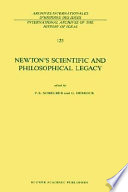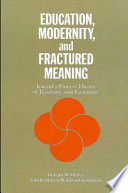 | Alfred North Whitehead - Science - 1925 - 240 pages
...formularised by Newton in his first law of motion: — 'Every body continues in its state of rest, or of uniform motion in a straight line, except so far as it may be compelled by force to change that state." This formula contains the repudiation of a belief which had blocked the progress of physics... | |
 | Leal Aubrey Headley - Study skills - 1926 - 448 pages
...members of the class, about which judgment is passed. I may judge that this leaf is green and that "every body continues in its state of rest or uniform motion in a straight line unless impelled by external force to change that state"; also that parts of the leaf are green and... | |
 | Robert Andrews Millikan, Henry Gordon Gale, Charles William Edwards - Physics - 1928 - 852 pages
...regarding them. Sir Isaac Newton merely crystallized such observations into his first law of motion : Every body continues in its state of rest or uniform motion in a straight line unless impelled by external force to change that state. After a law of nature has once been established... | |
 | Sir Arthur Stanley Eddington - Philosophy - 1928 - 380 pages
...deviation. We can improve on his enunciation of the First Law of Motion. What he really meant was — "Every body continues in its state of rest or uniform motion in a straight line, except in so far as it doesn't." Material frictions and reactions are visible and absolute interferences which... | |
 | Franklin D. Jones - Machinery - 1928 - 1254 pages
...physicist. It was put in the form of three laws, which are given as originally stated by Newton : I. Every body continues in its state of rest, or uniform motion in a straight line, except in so far as it may be compelled by force to change that state; II. Change of motion is proportional... | |
 | Paul B. Scheurer, G. Debrock - History - 1988 - 406 pages
...Celsius, a boiling point of 2.966 degrees Celsius and a specific gravity of 19.3 at 20 degrees Celsius. Every body continues in its state of rest or uniform motion in a right line unless it is compelled to change that state by forces impressed upon it. Different though... | |
 | Donald W. Oliver, Kathleen Waldron Gershman - Education - 1989 - 272 pages
...discovered: That the weights of two bodies are proportional to their masses. That every body perseveres in its state of rest or uniform motion in a straight line, except as compelled to change that state by impressed forces. That change of motion is proportional to the... | |
 | Julian B. Barbour - 1988 - 784 pages
...Aristotelian when, in his definition of inertia, he described the faculty by which any body remains in its state of rest or uniform motion in a straight line as a potentia. It is also worth noting that the modern word potential, as in potential energy, was... | |
 | Brian Cotterell, Johan Kamminga - Biography & Autobiography - 1990 - 348 pages
...laws of motion. A free translation of these laws from the Latin of the Principia goes as follows : I Every body continues in its state of rest or uniform motion in a straight line unless it is compelled to change that state by forces applied to it. II The rate of change of momentum... | |
 | Hankins - Medical - 1990 - 276 pages
...independently of the effects they produce. What d'Alembert should have said in his first law was that 'every body continues in its state of rest or uniform motion in a straight line until it strikes or is struck by another impenetrable body'. According to his own argument, this statement... | |
| |